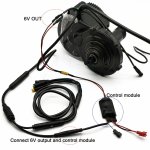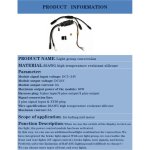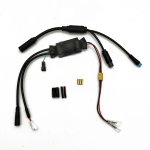cheating-is-awesome
1 µW
- Joined
- Jan 7, 2023
- Messages
- 3
I recently purchased a Magic Shine ME 1000 to add to my Bafang BBSHD bike. I was excited about having a setup that ran off one battery, the main battery, and being able to control the light from the existing display (an Eggrider v2). However, the light is not delivering the brightness claimed, not by a long shot. I'm not sure what the problem is at this point, and Magic Shine has so far been zero help over email. I'll try to start at the very beginning.
Anybody who has a BBSHD probably is aware the stock light power out is anemic, 6v 500mA. I wanted something more powerful.
To aid in this quest, I bought a light adapter module, this one. The purpose of the adapter is to allow the puny built-in 6v signal cable to activate what I can only imagine is a relay, and for that relay to provide more power to the light than 6v. It has the added benefit of making the brake light functional, but there is no problem with that functionality, so I believe we can just ignore that for the remainder of this post.
The module listing states the output power is 24 volts. The multimeter determined that to be a lie. It's putting out the full motor voltage, so for me 52 nominal volts. I wanted a 12v light, so I also bought a voltage step down, this one. The multimeter confirmed that was putting out 12v, so I'm all good.
The light adapter module states it can do 3 amps. The voltage step down states that it can output 12v 5 amps. The light, a Magic Shine ME1000, claims to need 1 amp at 12 volts for full brightness. So it seems all the components are rated high enough to deliver full power to the light.
After getting everything hooked up, immediately after turning on the light I thought to myself, "I should have gotten the brighter one". Riding around that night I could barely see that the light was on. Once I got back home I compared it to two other battery powered lights I have that I know the claimed brightness settings for (an Olight RN600 and a Fenix TK12v2). From just eyeballing it, the ME1000 appeared to be putting out around 250 lumens, +/- 50 lumens. The stated max lumens on the ME1000 is 1000, so clearly something is wrong.
My initial thought was that the Ali Express components were not doing what they were supposed to be doing. I thought, if I could plug it into something that I was more sure would deliver the full power, then I could know whether it was my ebike wiring or the light. I looked around my apartment and found not one, but two AC->DC adapters that output 12 volts. The claimed amps out were 1 amp and 2 amp, so they should both be able to deliver full power to the light. I plugged both into the light and the results were the same, the light seems like it's putting out a measly 250 lumens. I could not visually tell any difference from when it was plugged into the ebike. Putting the multimeter inline shows the light only pulling .22 amps. The kill-a-watt that I plugged the DC adapters into show between 3.3 and 4.2 watts being drawn. This aligns with my visual estimation that the light is only putting out about a quarter of the light it should be.
I emailed Magic Shine about this. Their first and only response so far was basically "Yes, the RN600 (one of the lights I compared it to) and ME1000 are different lights, so the light output is different". I had written almost all of the details I wrote above. Whoever read and responded to my email clearly didn't understand it in the slightest.
Wiring this all up took so much time and effort. Waiting for the parts, trying to make the wiring clean. I can't express how disappointed I am in this outcome.
I suppose my question is, is there any other troubleshooting steps I could take, and what are they? Is this a common or known issue with this brand?
Anybody who has a BBSHD probably is aware the stock light power out is anemic, 6v 500mA. I wanted something more powerful.
To aid in this quest, I bought a light adapter module, this one. The purpose of the adapter is to allow the puny built-in 6v signal cable to activate what I can only imagine is a relay, and for that relay to provide more power to the light than 6v. It has the added benefit of making the brake light functional, but there is no problem with that functionality, so I believe we can just ignore that for the remainder of this post.
The module listing states the output power is 24 volts. The multimeter determined that to be a lie. It's putting out the full motor voltage, so for me 52 nominal volts. I wanted a 12v light, so I also bought a voltage step down, this one. The multimeter confirmed that was putting out 12v, so I'm all good.
The light adapter module states it can do 3 amps. The voltage step down states that it can output 12v 5 amps. The light, a Magic Shine ME1000, claims to need 1 amp at 12 volts for full brightness. So it seems all the components are rated high enough to deliver full power to the light.
After getting everything hooked up, immediately after turning on the light I thought to myself, "I should have gotten the brighter one". Riding around that night I could barely see that the light was on. Once I got back home I compared it to two other battery powered lights I have that I know the claimed brightness settings for (an Olight RN600 and a Fenix TK12v2). From just eyeballing it, the ME1000 appeared to be putting out around 250 lumens, +/- 50 lumens. The stated max lumens on the ME1000 is 1000, so clearly something is wrong.
My initial thought was that the Ali Express components were not doing what they were supposed to be doing. I thought, if I could plug it into something that I was more sure would deliver the full power, then I could know whether it was my ebike wiring or the light. I looked around my apartment and found not one, but two AC->DC adapters that output 12 volts. The claimed amps out were 1 amp and 2 amp, so they should both be able to deliver full power to the light. I plugged both into the light and the results were the same, the light seems like it's putting out a measly 250 lumens. I could not visually tell any difference from when it was plugged into the ebike. Putting the multimeter inline shows the light only pulling .22 amps. The kill-a-watt that I plugged the DC adapters into show between 3.3 and 4.2 watts being drawn. This aligns with my visual estimation that the light is only putting out about a quarter of the light it should be.
I emailed Magic Shine about this. Their first and only response so far was basically "Yes, the RN600 (one of the lights I compared it to) and ME1000 are different lights, so the light output is different". I had written almost all of the details I wrote above. Whoever read and responded to my email clearly didn't understand it in the slightest.
Wiring this all up took so much time and effort. Waiting for the parts, trying to make the wiring clean. I can't express how disappointed I am in this outcome.
I suppose my question is, is there any other troubleshooting steps I could take, and what are they? Is this a common or known issue with this brand?




